Where are the Aardvarks?
Guest blog by Zooniverse volunteer, Lee Reiswig:
I’ve spent the last couple of days exploring WildCam Gorongosa data looking for insights into the Gorongosa aardvarks. I was motivated by numerous comments in Wildcam Talk about how rare aardvark sightings are.
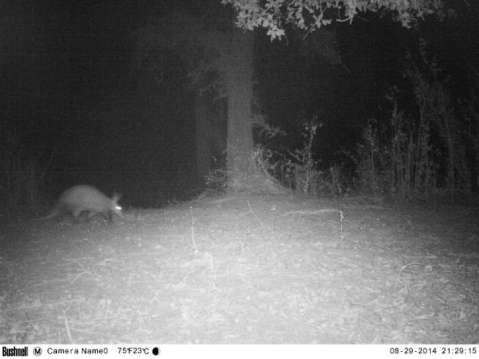
I started with the Wildcam Lab as an Explorer. The Lab houses a downloadable database of over 40,000 classified trail cam images. The download data includes links to the images and date, time, location, and other classification data. The image downloads can be filtered by many characteristics like species, habitat, seasons, etc. The downloaded data is in .csv format and can be processed by many programs like Microsoft Excel.
My initial “aardvark only” download from the Wildcam Lab produced only 16 images and three of those were not Aardvarks. So I decided to do a hashtag search for Aardvarks and the search returned about 100 more images classified as Aardvarks. I weeded out the incorrect classifications (white tailed mongoose, bushbuck and porcupine plus others). Here’s an example of a white tailed mongoose that was hashtagged aardvark:
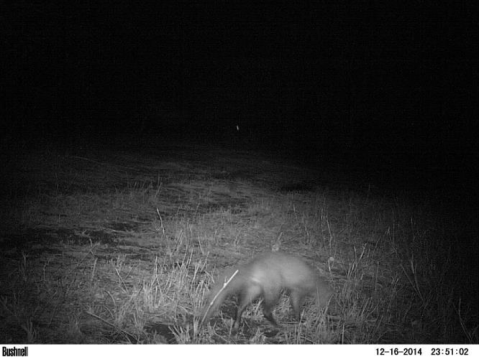
Then I added to the download worksheet the images before and after those in the lab and search data. I used Nor’s widget ( http://njstargazer.org/gorongosa.asp) to move through the image sequences to include all the images that contained Aardvarks. I ended up with only 126 images over the 3 years. Not many!
Those 126 images were from only 27 unique sightings or sequences based on the date and time stamps. All were of single individuals foraging at night.
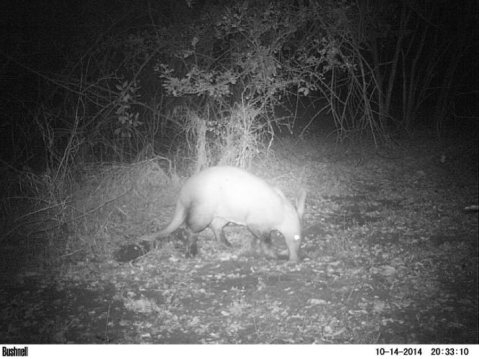
That likely means there are less than 27 total Aardvarks in the area monitored by these cameras! No young appeared in the images.
Only 10 cameras had images of Aardvarks. I divided them into three geographic areas: Southwest – C06, C08 & D10; Southcentral – C15, D14, D35, D61 & D73; and Northeast – D56 &D57. There was a significant shift in sightings in these areas from 2013 to 2014 (only two sightings in 2015 so I excluded them).
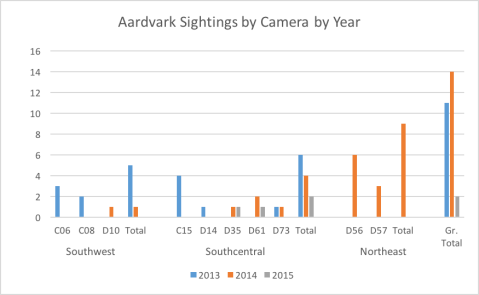
There was roughly a 25% increase in sightings in 2014 (14) from 2013 (11) but there were only two sightings in 2015?
In 2013, there were five sightings in the Southwest and six in the Southcentral and none in the Northeast. In 2014 that changed. There was only one sighting in the Southwest and four sightings in the Southcentral and remarkably nine unique sightings in the Northeast. Of course, there could be many explanations for this including when the cameras were running and where as well as many other factors.
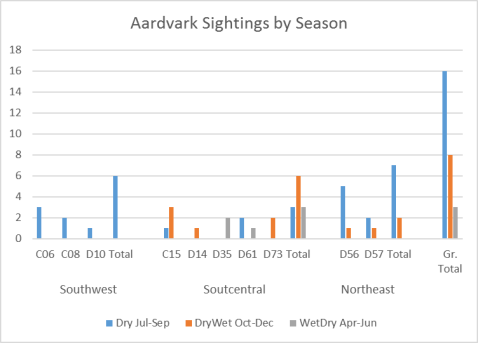
I also looked at the sightings by season. There are twice as many (16) in the Dry (July – Sep) season as there are in the transition to Wet (Oct – Dec) season. There were no sightings in the Wet (Jan-Mar) season and only three in the transition to Dry (Apr-Jun) season.
Wildcam is such an amazing project that we lay persons can explore and learn to our hearts delight. I’m happy to share my Excel worksheet with any of you that would like to see and use it. Send me @LeeReiswig a message and I can email or put it in the cloud for access. Enjoy exploring Gorongosa with these wonderful tools!

Good job uncle
LikeLike
Are you only researching aardvarks? Or are you also researching other cool animals that your into?
LikeLike
Hi there, Do you own the copyright to these images? I was just wondering if I could use these in a television show.
Thanks!
Megan
LikeLike